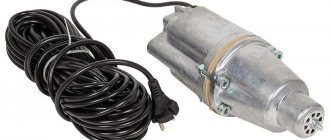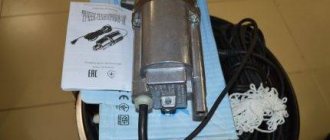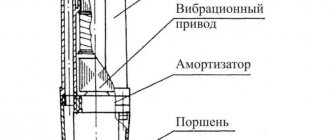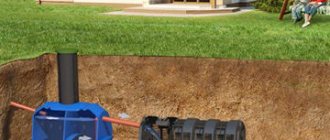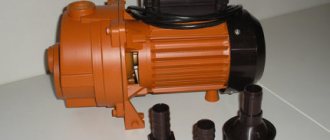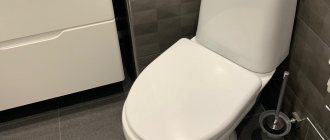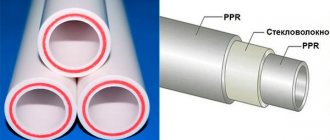Baby water pump, basic model
The most inexpensive but reliable devices for pumping water from wells and shallow wells include the Brook or Malysh pump. They are distinguished by their simplicity of design, stable operation, durability, and a pleasant price-technical capabilities ratio.
The types and parameters of the Baby will be discussed in this article.
Pump “Baby”: where is it used?
Most often, an inexpensive vibration pump can be found in garden plots and vegetable gardens. Sometimes it is used on farms and farmsteads. The equipment is a universal device and can be used in the following areas:
- Watering and irrigation . “Malyshok” is used both in small areas and in fields. With its help, water is collected to create artificial ponds and swimming pools, and vice versa, it is pumped out for drainage.
- Cleaning up flooded buildings . Some models with filters that are resistant to contaminated water can be used to remove liquid from flooded areas.
- Injection from a drilling source . The characteristics of the “Malysh” submersible pump allow you to quickly fill containers and the water supply system in a country house or in a small private house.
It is important to understand that different models of equipment are used for clean and contaminated water. So, for purified substances, an option with lower absorption is suitable, and for water with waste fractions, it is better to buy an option with an upper intake.
Using a pump in the country Source userapi.com
Manufacturers
The names “Baby” and “Stream” have long become household names. This is what small submersible vibration pumps are called today. Initially, they were produced exclusively in Russia or in neighboring countries, but today there are plenty of Chinese “Kids” on the market. In general, there are several manufacturers of such pumps in Russia:
- In the city of Livny in the Oryol region and in Bavleny, Vladimirskaya, it is Babies that are produced. Most come with an upper water intake, Little M - with a lower one.
- Babies are also produced in Klimovsk, Moscow region.
- In Kursk and Kirov (Lepse plant) they produce pumps of the same type, but under different names - Aquarius.
- In Bryansk (Topol enterprise) Rodnichki are produced. Submersible pumps with the same name are produced in Chelyabinsk, as well as by the company Zubr.
- Rucheek units are produced in Mogilev (Belarus).
Different names and companies, some differences in characteristics, but all these are submersible vibration pumps of the Malysh type
The rest of the brands are Chinese. How to determine? Carefully examine the packaging and passport. If it is a Russian manufacturer, there must be an address, the name of the enterprise, a list of service providers, etc. If there is no such information, this product comes from the DPRK.
Water intake: use and operating principle of different products
There are many pump models, and the differences are often due to manufacturers. However, the traditional classification divides equipment into 2 types:
- Upper water intake . The most common option, due to its better protection against clogging. The design is such that the engine is located under the valve, into which water is pumped and supplied further. This prevents excessive heating, and if the water drops below the permissible level, the mechanism automatically turns off. The engine itself remains in the water. Since the suction occurs from above, much less debris from the bottom penetrates inside. The only drawback of the equipment is dry operation in the absence of an idle relay. This is necessary to prevent air from being sucked in.
- Lower water intake . This “Baby” is more often used in deep wells, where it can be installed far from the bottom. It is dangerous to use the device without a thermal protection relay. This is due to the fact that the engine is located above the pipe. The absence of a relay leads to rapid overheating and breakdowns. The equipment also needs sand and debris filters.
The technical characteristics of the “Malysh” water pump differ from different manufacturers. There are 4 classic types of vibration devices.
“Baby” device with upper water intake Source cloudinary.com
Classic model
In this version, vibration equipment is used for small sources with a diameter of more than 10 cm. The pump can be used to supply through a hose at a distance of up to 150-200 m, however, solutions with a limit of up to 100 m are more common. Equipment with cool liquid is used. A lower pipe is used for water intake.
| Properties and parameters of the classical model | |
| What power does it work with? | The model is characterized by an average of 220-245 W |
| Can lift water to heights | up to 40 m |
| Nutrition | 220 V |
| Performance | At 1 m height – 1050 l, at 40 m – 430 l. Parameters are given for hours of operation. |
| Pump lowering depth | no more than 5 m |
| How long can it function? | 2 hours without a break |
| Weight | 3.5 kg |
| What pressure does it give? | 0.4 mPa |
For the “Malysh” pump you need a hose with a diameter of 18-22 mm . When purchasing this model, you need to take into account that the cord is often completely missing from the kit. It is selected according to length based on needs. Options with protective relays and other parts included began to appear. However, the cheapest offers do not include them.
Pump model “Baby classic” Source onlinetrade.ru
Model "Malysh-M"
Almost complete analogue of the previous model. However, the pump is made with a pipe for upper water intake.
Option "Baby-K"
Another version of the basic model, which matches the parameters 100%. However, the package includes an overheat protection relay.
See also: Catalog of companies that specialize in the design and installation of sewerage and water supply
Series "Baby-3"
An improved model of a submersible pump with improved equipment. It is used in wells and boreholes with shallow immersion depth and a diameter of 8 cm. Distinctive features include:
- completely monolithic block, completely insulated along with the electrical wire;
- not so much power required for use in low-yield wells - 165 W;
- Can be submerged to depths of up to 20 m while maintaining a capacity of 0.43 cubic meters. m/hour;
- weight not exceeding 3 kg.
The diameter of the hoses used is 25 mm, or 3/4 inches. Even the factory equipment contains an integrated electrical cable 30 m long.
Pump “Malysh-3” with a long cable Source blogspot.com
Specifications
As has already been said, Malysh submersible pumps have low power - mostly about 250 W, that is, it is not able to create high pressure. Their clones with other names can be found slightly more powerful.
What is also important is the lifting height - this is how far water can be pumped. In the technical specifications, it should be about 20% greater than what you need.
Pay attention to the power supply for which this model is designed. Usually this is 200 V with possible small deviations of the order of 5%, but the reality is that the network can be 240 V, and at such a voltage a pump with such characteristics will burn out. The solution is to install a stabilizer or look for a model with a higher operating voltage (a decrease from the operating voltage does not have such a negative effect on the work - the power decreases).
The length of the electric cable can be from 10 meters to 40
Another important indicator is productivity. It is usually indicated in liters per minute or per second. This value shows how much water the unit is able to pump under normal conditions. For this type of equipment, this figure is quite small - about 400 ml/sec. Such a submersible pump Malysh can provide water to one water collection point - one irrigation hose or tap in the house. He is not capable of anything more without additional equipment.
| Name | Water intake | Idle/overheat protection | Power | Performance | Lifting height | Diameter | Immersion depth | Price |
| Malysh-M P 1500 Topol | Upper | no Yes | 240 W | 24 l/min | 60 m | 99 mm | 3m | RUB 1,741 (plastic) |
| Rucheyok-1 Mogilev | Upper | no no | 225 W | 18 l/min | 72 m | 110 mm | RUR 1,459 (cord 10 m) | |
| PATRIOT VP-10B (USA/China) | Upper | no no | 250 W | 18 l/min | 60 m | 98 m | 7 m | RUB 1,760 (cable length 10 m) |
| BELAMOS BV012 (Russia/China) | Lower | no no | 300 W | 16.6 l/min | 70 m | 100 mm | 3m | 2110 RUR (cord 10 m) |
| Malysh-M 1514 Topol | Upper | no Yes | 250 W | 25 l/min | 60 m | 98 mm | 3m | RUR 2,771 (metal, cord 40 m) |
| Caliber NVT-210/10 (Russia/China) | Upper | no no | 210 W | 12 l/min | 40 m | 78 m | 10 m | 1099 RUR (cord 10 m) |
| Bison MASTER Rodnichok NPV-240-10 | Upper | no no | 240 W | 24 l/min | 60 m | 100 m | 3m | 1869 RUR (cord 10 m) |
| QUATTRO ELEMENTI Acquatico 250 | Upper | no no | 250 W | 17.5 l/min | 75 m | 100 m | 2 m | RUR 2,715 (cord 10 m) |
| Aquarius-3 (Lepse) | Upper | no/is | 265 W | 26 l/min | 40 m | 98 mm | 1900 RUR (cord 10 m) | |
| Baby 25 m (Kursk) | Lower | Not really | 250 W | 7.1 l/min | 40 m | 1920 RUR (cord 25 m) |
Each type of pump is available with a different length of electrical cord and this changes the price (the longer the cord, the more expensive). You can also find varieties with dry run protection, but you can make your own (see below).
The operating principle of the “Baby”
The not too complicated and reliable design, as well as the good characteristics of the Malysh pump, make it an excellent option for simple and economical use. It consists of a sealed housing, protected from liquid penetration, and an electric drive located in it. The drive contains a core, an electrical wire, a vibrator and two coils.
Options with top water injection are equipped with a valve to close the inlet in the absence of water pressure in the top part of the body. In a model with a lower intake, such a valve is located at the bottom.
Pump operating principle
The baby (in fact, like any other vibration-type unit) operates on an inert principle - in other words, there is a special vibrator inside the pump that gives the water oscillatory movements. The vibrator itself is made in the form of an anchor with a rod attached to it. After turning on the equipment, the armature is attracted to the magnet, after which the latter is turned off, and it (the armature) returns together with the rod to its original position thanks to a special spring. The frequency of such oscillations is about 50 times per second.
From all of the above, we can conclude that the Malysh, having such a simple design, due to its characteristics, is still capable of maintaining a fairly high pressure in the system.
Video description
The video below clearly shows the operating features of the pump:
The operating principle of the “Malysh” pump is very simple and is based on the use of alternating current. Its force activates the anchor and the piston, which create movement and force water into the pipe.
You can find a large number of “Baby” type pumps on sale, but they may have a different name. They are made by Chinese, Russian, some European and American brands. Their parameters are approximately the same, and the power is in the range of 220-250 W. The throughput, or performance, of these models can differ by almost 2 times. For example, for the “Malysh MP 1500” it is equal to 24 liters, while for its analogue “Caliber NVT” the figure will be only 12 liters. The diameter of the pumps themselves usually also does not exceed 110 mm.
The cost depends not only on the characteristics of the “Malysh” vibration pump, but also on the length of the cord. The larger it is, the more expensive it is.
Preliminary preparation of the pump for operation
First of all, you must ensure that you have a flexible hose (made of plastic or rubber) with an internal diameter of at least 1.8 centimeters. If the product has a smaller diameter, then it should not be used for the pump, as it can create an excessive load on it. In addition, water can be supplied through pipes (metal or plastic), but, nevertheless, they will still have to be connected to the unit itself only through a flexible hose, the minimum length of which will be 2 meters.
Note! To connect the hose to the corresponding pump connection, you will need a clamp. If the equipment will be used in winter, it is advisable to make a small hole (1.5 millimeters in diameter) in the hose near the body, thanks to which you will be able to prevent the water from freezing and ensure its unhindered outflow. Later, when summer comes, this hole can be sealed with something.
After this, you need to take a ten-meter nylon cord and secure it to the eyes of the unit (this cord is present in the basic configuration of the Baby). To increase the length, you can use wire - connect it with the same nylon cord. Under no circumstances should you screw an iron cable or wire directly to the unit body, otherwise the mounting holes may simply become unusable.
We continue to connect the Malysh pump ourselves. Note that you must determine in advance what the distance is between the water source and the electrical outlet. It is this indicator that will affect the length of the cable that will be required to connect your pump to the power supply. The device comes with a cord, the length of which can vary between 6-40 meters, which you yourself may have noticed when studying average market prices and characteristics. To find out a more accurate cord length, you will need to, again, look at the manufacturer's instructions.
As a result, the following components must be connected to the pump:
- nylon cord;
- rubber/plastic hose;
- electrical cable.
We recommend connecting them all to each other using regular tape - wrap it in increments of 10-20 centimeters. Typically, the first such connection should be located a maximum of 20 centimeters from the unit body.
Now let's look at how the Baby should be installed in a well.
Features of hose selection
One of the main difficulties when purchasing equipment for many users is choosing the diameter of the hose for the “Malysh” pump. How long the device will last depends on this parameter. When choosing, take into account the following features:
- a nozzle is put on the part of the hose immersed in water to filter dirt and large particles;
- Before starting, the hose must be filled with water;
- if the pump will be used all year round, then you need to select an accessory with high resistance to frost;
- rubber products are not suitable for use with the “Kid”;
- When working with a well, HDPE pipe is used.
The diameter of the hose determines how much water it can pass through. The most common and versatile option is 25 mm or ¾ inch. A smaller diameter can be used if you need to connect communications directly to the water supply system. But the instructions may have certain restrictions.
Reinforced watering hose for “Baby” Source uvelirstudio.ru
Features and operating requirements - how to use the Baby
Before you connect and start up your newly purchased unit, we recommend that you familiarize yourself with the basic rules for its safe use. You should be aware of some restrictions - if any exist, then using the Baby in this case is strictly prohibited. So, all these restrictions are given below.
- First of all, the Baby cannot be used if its cord is damaged or if there is increased voltage in the network.
- It is also important that continuous operation is no more than 2 hours (unless otherwise provided by the design), and the unit must be periodically turned off for approximately 20 minutes.
- If the equipment is working, then under no circumstances should the liquid supply be shut off.
- Finally, the total daily operating time of the unit should be a maximum of 12 hours.
It is worth noting that all this is described in detail in the manufacturer’s instructions - be sure to study it in advance in order to avoid certain unforeseen consequences.
Well: installation rules
Before starting work, the pump must be installed correctly. To do this, use a synthetic cable, tying it to special eyes on the body. The node should be 10 cm from the body or higher. The edges are then seared to secure it.
Important! It is possible to use a metal cable secured at least 2 m from the body on a synthetic rope. Otherwise, the metal will quickly collapse from vibration.
Next, proceed to connecting pipes and hoses:
- A suitable hose is attached to the pipe through which the pump pumps water. It is important that the diameter of the “Malysh” pump hose is larger than the part on which it is installed. However, an accessory that is too narrow will increase the load on the device. The optimal size is 2-3 mm larger.
- If a pipe is used, it is also connected to the pipe with a hose, the length of which must be at least 2 m.
- A metal clamp is used for fastening. To prevent it from jumping off, you can sharpen the pipe with a file to increase adhesion. Or make a groove for a wire clamp. The material for fastening is stainless steel with notches.
Steel clamp for fastening the hose Source boltmix.ru
- After the initial manipulations, the hose, cable and cable are connected and secured with constrictions. The first should be 25-30 cm from the body. For the rest, a step of 1-2 m is assumed. For constrictions, adhesive tape is used, since metal can damage the cord and twine.
- A strong crossbar is installed on top, on which the cable is fixed. You can also make a hook on the side wall for this purpose.
- Immerse the equipment to the required depth in accordance with the instructions.
During installation, it is important to remember that the “Baby” should not come into contact with the walls of the well or well.
Advice! When installing in a well with a low water level with a cable length of up to 5 m, the product must be suspended on a spring gasket to the crossbar.
This approach will reduce vibration. You can use a piece of rubber to distribute the weight.
Application area
The Malysh submersible pump has a low price and is suitable for pumping clean water. It is better not to pump heavily contaminated water with it - it will quickly burn out. It is used in the following cases:
- for watering the garden;
- for collecting water into storage tanks;
- for water supply at home, but with certain restrictions (more on this below).
The Baby submersible pump can pump water from a well, a natural source - a pond, river, lake. It is suitable for dispensing water from containers. It can also be used for wells, but with reservations. Since the pump type is vibrating, it creates vibrations in the water column, lifting the smallest particles (silt, clay, sand) from the bottom and sucking them in. If in the case of a well this does not threaten anything other than opaque water, then when using a Malysh pump in a well it can silt up faster. In any case, this is the common opinion.
To prevent the Baby submersible pump from hitting the walls in a well or well, rubber shock absorbers are put on its body
Manufacturers in their recommendations for use indicate the minimum diameter of a well or well - 90-100 cm, some models (Kid 3) can work in sources with a diameter of 70-75 cm. However, they are also used in very narrow wells. The main thing is that he gets there. But at the same time it hits the walls of the well, creating additional vibration and threatening to split the casing or damage its own casing. To reduce beating, rubber rings are put on the body (pictured above). They solve the problem.
Video description
What to do if the pump gets stuck in the well after installation is shown in this video:
Horizontal installation in a river or lake
Since the technical characteristics of the Malysh pump allow it to be immersed even in natural open sources of water, it is important to install the equipment correctly. The process is different from installation in a well.
Prepare the pump in the same way as for a well: put on a hose and tighten it. And the body is protected with a rubber sheet 2-3 mm thick. Immerse the structure in water and turn it on.
Installation and connection features
The main rule: the pump must be mounted in a vertical position, otherwise its service life will be seriously reduced. And the depth of its immersion should be such that the suction hole is always in the water. Therefore, you need to know the lower dynamic water level in your source.
Dynamic and static levels
For reference. The dynamic level is the mark at which the water in the well is kept when the pump is running. It depends on its performance.
Installation instructions:
- Prepare a water supply hose. Its length should correspond to the immersion depth, and its diameter should correspond to the diameter of the pressure pipe;
- Secure the hose to the pipe using a plastic clamp;
- Secure the filter to the suction pipe. This is especially true for pumps with bottom water intake, since mechanical impurities entering the working chamber of the device lead to rapid wear of the check valve and piston, clog the hose, which leads to a critical increase in pressure inside the device;
Advice. Pumps with bottom water intake should not be placed closer than 50 cm from the bottom of the well or well, even if they are equipped with a filter.
- Make sure the network cable is long enough. If this is not the case, you need to build it up with your own hands, but so that the connection point is above the level of the well;
- Use plastic clamps to combine the hose and cable so that the latter cannot slide down, but is in a loose state;
Installation of a pump in a well
- If there is a very small gap between the pump and the walls of the well casing, then a rubber ring must be put on its body, which will prevent mechanical damage to the device from vibration;
- Fix the steel cable or nylon cord that comes with the pump into the special eyelet on the body. Tie an elastic rubber band about 50 cm long tightly to its upper end - it will dampen vibration;
- Lower the pump on the cable into the source to the specified depth, then carefully secure the cable from the outside.
Now you can plug the cable into the network and use the device. Connection is possible only after complete immersion, since idling will quickly lead to failure.
Unfortunately, the pressure the Malysh pump creates does not suit everyone, especially if there are devices in the house, for the normal operation of which it must be at least 2 atm. Vibrating devices, in principle, are capable of producing it, but if the source is located far away, then significant pressure losses occur in horizontal sections.
But there is a way out: the pump must be additionally equipped with a check valve, a pressure switch and a hydraulic accumulator, turning it into a mini-pumping station. Automatic maintenance of the water level in the accumulator is carried out using a relay: it turns on the pump when the pressure in it drops.
In the photo you see everything that is needed to set up a pumping station
Automation for pump
Recommended automatic devices include:
- Dry running controllers that turn off the unit when air or sand gets into it;
- Float switches that operate when the water level drops;
- Pressure switch and thermostat;
- Stabilizer for the Baby pump, maintaining the current constant during pressure surges;
- Start protection devices;
- Check valves;
- Hydraulic accumulators that maintain network pressure through a pressure switch.
To get an idea of how it all works, we suggest studying the following diagram:
Hydraulic accumulator for the Malysh pump - connection diagram
- 1 – control unit;
- 2 – cable with plug for connecting to the network;
- 3 – cable with socket for connecting the pump;
- 4 – automatic switch;
- 5 – socket;
- 6 – pump Malysh;
- 7 – power cable;
- 8 – nipple;
- 9 – check valve;
- 10 – pressure pipeline;
- 11 – cross;
- 12 – adapter nipple;
- 13 – flexible liner;
- 14 – hydraulic accumulator;
- 15 – distribution pipeline.
When the pump is turned on, it supplies water to the hydraulic accumulator connected to the automation system. When the pressure in it reaches the nominal value, the pressure switch turns off the pump and turns it on again when it drops.
5 liter hydraulic tank with pressure switch
Advice. To drain water from the system for the winter, install a ball valve between the filter and the check valve.
Frequent breakdowns and options for eliminating them
Some users experience that the device does not pump water. The most common causes and ways to solve them include:
- loosening the locknut in the pump - you can tighten it and get rid of the problem;
- breakdown of the pumping cuff - the product is disassembled, a part is found that looks like 2 saucers, and it is replaced with a new one;
- output of the pumping rod - it is located next to the motor and requires professional repair.
Sometimes the pressure switch fails. It can also only be repaired at a service center.
Internal structure of the “Baby” Source oboiman.ru
We install the connected unit into the well
Let's start with the fact that the described pump inevitably vibrates during operation, and therefore may well come into contact with the walls of a small well or casing pipe, due to which the housing will sooner or later be damaged, and the equipment itself will simply fail. To avoid all this, we recommend putting a suitable rubber ring on the unit before immersing it in water - it will absorb future shocks and also act as additional protection for the Baby.
When lowering the pump into the well, you must position it correctly - it is important that the device is positioned level and does not touch the walls. At the top of the well/well, it is necessary to install a bar, to which, in turn, a suspension made of an elastic but sufficiently durable material should be attached. Thanks to this suspension, vibrations during operation of the device will be noticeably reduced.
What should it be made of? The most popular options include a medical tourniquet and a piece of rubber hose. In this case, the upper end of the cable must be connected to the suspension to create the proper tension. As for the electrical cable, excessive tension is contraindicated for it - it is necessary that it lies freely on the bar.
Note! The baby you just purchased is completely ready for use; you do not have to lubricate it or fill it before using it. If the unit’s protection class is 1, then additional grounding of the outlet will be required. Finally, the pump can be turned on directly after you immerse it in water.
If you plan to pump water from a shallow reservoir or pump out the previously mentioned flooded basement, then the device can be lowered to the bottom if you wrap it in thick fabric in advance or, alternatively, place a rubber sheet under the body.
How to extend the life of the pump
In order not to fall over time, and to ensure that it works properly throughout its entire service life, it is important to follow some recommendations:
- replacing ferrous metal bolts with stainless steel ones;
- regular check of fasteners on the body and in the piston area;
- you can close the bolts with a layer of superglue;
- regular inspection - once a year the pump is disassembled, cleaned, cracked elements are replaced;
- When the level in the source constantly changes, models with upper water intake are purchased.
Before use, it is important to study the data sheet for the pump. Although many models have the same characteristics, their use may vary greatly.
How to make repairs correctly?
As we have already found out, the need for repairs often arises due to clogging, so the unit should be periodically disassembled and cleaned. An approximate sequence of the procedure is given below.
Step one. First, the pump is removed from the well and marks are made on its body to indicate the relative positions of the structural elements. Thanks to this, further assembly upon completion of the repair will be noticeably easier.
Step two. After this, loosen each screw in turn that connects the housing elements to each other. During subsequent assembly, it is advisable to replace simple screws with others, for a hex key, or with bolts with perpendicular slots. To make loosening the screws easier, clamp the housing with a vise where there are ledges for the screws.
Step three. When the unit body has already been removed, the piston disc is installed. This point is extremely important, since installation must be carried out exclusively parallel to the saddle.
Important information! For the most accurate control of the parallelism of the installation of this disk, we recommend using a caliper.
A disassembled device can be cleaned and repaired. During subsequent assembly, you need to make sure that the holes match. To check the functionality of the unit, you can lower it into a bucket filled with water. It is important that the height of the stream that comes out of the corresponding pipe is about 30 centimeters.
Video - Equipment prevention and repair
Briefly about the main thing
The budget pump “Malysh”, the technical characteristics of which make the equipment universal, is used to remove water from flooded areas and to treat plantings on the site. The most reliable option is a top-type pump.
The key parameters of the standard models “Malysh” and “Malysh-M” include:
- average power 220 W;
- immersion depth – from 3 to 7 m;
- productivity – 12-20 l per minute;
- water supply for a length - from 100 m;
- Some models are equipped with overheating protection.
There is also a newer model that has reduced power and can be immersed to a shallower depth for efficient operation. This is “Kid-3”.
When connecting the pump, polymer hoses or pipes are used. It is very important to install it strictly following the instructions, securely fixing the hoses with a clamp and preventing the body from rubbing against other elements.
Ratings 0
Purpose of the deep vibrator
Submersible pumps of the “Malysh” series are produced by the Russian company Livgidromash, whose history goes back almost seventy years. During this time, more than three million units of various pumping equipment rolled off the plant's assembly line.
Despite the wide selection of submersible units that the market offers today, many consumers choose the products of the Livensky plant. And it is no coincidence that “Malysh” pumps, thanks to their good technical characteristics, ease of use and low cost, withstand the competition with dignity.
The Malysh pump is an affordable and easy-to-maintain unit that allows you to provide water to summer cottages that do not have a centralized water supply.
The device, small in size (up to 255 mm) and weight (up to 3.4 kg), will cope with a number of tasks with a bang.
It will provide:
- uninterrupted supply of water from wells and wells having an internal diameter of 8 - 11 cm, as well as any reservoirs with a water temperature of no higher than 35 degrees;
- pumping water from open sources located at a distance of more than one hundred meters from a house or summer cottage;
- transportation of water from the storage tank and directly into the water supply system of the house;
- forming a supply of water for abundant watering of plants in the open ground or in a greenhouse, for maintaining the territory and for other economic purposes;
- pumping water from basements when they are flooded with flood waters;
- filling country pools and draining water;
- pumping dirty water from silted or newly drilled water intake.
It should be noted that “Baby” can work productively only if the amount of impurities of mechanical particles does not exceed 0.01%. When pumping water from heavily silted sources, as well as from rivers with a significant sand content, it is necessary to use a filtration system.
The electric pump can be used for emergency pumping of water from flooded rooms. To avoid mechanical damage, it is necessary to lay a rubber sheet under it.
Details about the applications of the pump
Such a device has a vibration mechanism and is operated at depth when immersed in liquid. Accordingly, for normal operation of the submersible pump, the design provides a sealed housing with an appropriate degree of protection. This version represents a universal technique, which allows it to be used in different areas and to solve a variety of problems, including:
- maintenance of residential buildings and non-residential facilities;
- provision of irrigation in summer cottages and suburban areas;
- with the help of this device it is very easy to organize an automatic irrigation system using special nozzles;
- pumping out water, but here it should be clarified that it is not recommended to immerse the pump in too contaminated liquid.
A distinctive feature of such equipment as the Malysh submersible pump for the well is its reliability, which, along with its affordable price, ease of operation and unpretentiousness of the mechanism, significantly distinguishes it from a large number of analogues. But at the same time, the service life of the device is not very long-term, since on average equipment of this type is used for 2.5-3 years.
